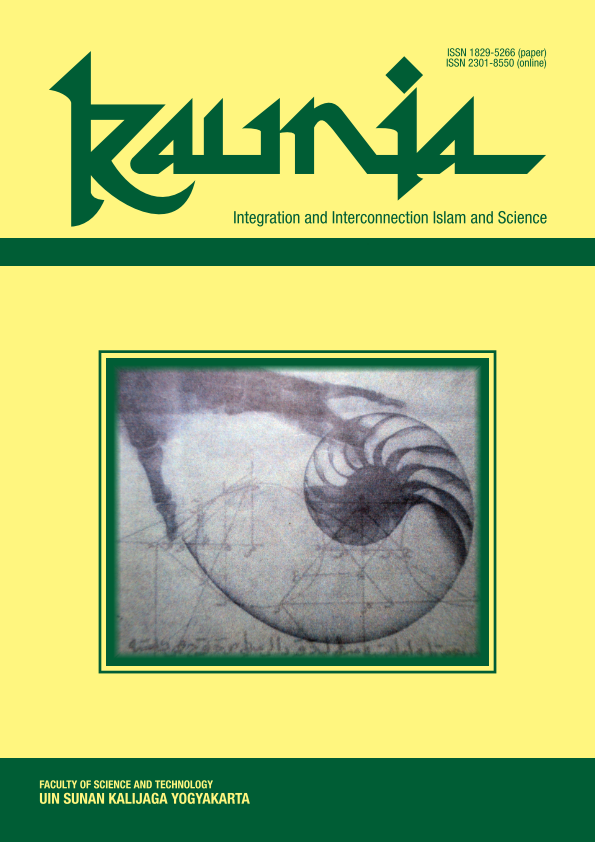Using Family Taxon as an Indicator of Haram Halal of Reptiles in Animal Systematic Lab Work
DOI:
https://doi.org/10.14421/kaunia.2419Keywords:
Reptile, Haram Halal, Familia Taxon, Integration and Interconnection Islam and ScienceAbstract
Haram halal of an animal are usually refer to the four mahzab in Islamic believe. This study discussed about halal haram of reptile class that will would be connected with its taxon family as an indicator. This research aims to set the family taxon as an indicator in determining halal haram of reptiles Literature study was done, tracing the written manuscript of Islamic and Science journals, books, websites or other relevant sources that can be used as a reference. The study showed that if a species in the family taxon is classified as halal to the Islamic Law, then the rest of the members in the family were considered as halal.
References
AL-Hazmi, Mansour A. (2011). Feeding Behaviour and Food Selection of Dhab Uromastyx microlepis from Wild Vegetation. Qatar Univ. Sci. J., 21: 65-73
Afiqah Salahudiin, Muhd Imran Abd Razak, Muhammad Izzul Syahmi, Mohd Anuar Ramli (2017). Issues in Halal Meat Product and Authentication Technology from Islamic Perspectives. International Journal of Academic RESEARCH IN Business and Sosial Sciense. Vol.7, No.12, pp. 1305-1315
Qardawi, Yusuf (1993). Halal dan Haram Dalam Islam. Diperoleh dari https://cahayamalamdibulanjuli.wordpress.com/2011/05/
Shine, Richard., Scott Keogh, Paul Doughty and Hamlet Giragossyan. (1998). Costs of Reproduction and The Evolution of sexual Dimorphims in a ‘Flying Lizard’ Draco melanopogon (Agamidae). J. Zool., Lond (246), 203-213
Sutriyono (2017). Study of Halal and Haram Reptil (Dhab “Uromastyx aegyptia”, Biawak “Varanus salvator”, Klarap “Draco volans”) in Interconnection-Integration Perspectiv in Animal Sytematics Practicum. Kaunia, Vol.XIII, Num.3, October2017, pp.25-29
Wilms Thomas M., Philipp Wagner, Mohammed Shobrak, Nicola Lutzmann & Wolfgang Bohme (2010). Aspects of ecology of the Arabian spiny-tailed lizard (Uromastyx aegyptia microlepis Blanford, 1875) at Mahazat as-Sayd protected area, Saudi Arabia. Salamandra 46 (3) hal 131-140
Wilms Thomas M., Philipp Wagner, Mohammed Shobrak, Nicola Lutzmann & Wolfgang Bohme (2009). Activity profiles, habitat selection and seasonality of body weight in a population of Arabia Spiny-tailed Lizards (Uromastyx aeegyptia microlepis Blanford, 1875; Sauria: Agamidae) in Saudi Arabia. Seiten 259–272
Downloads
Published
How to Cite
Issue
Section
License
Copyright (c) 2020 Kaunia: Integration and Interconnection Islam and Science

This work is licensed under a Creative Commons Attribution-NonCommercial-ShareAlike 4.0 International License.
All articles published in Kaunia are licensed under a Creative Commons Attribution-NonCommercial-ShareAlike 4.0 International license, with the copyright to these articles held by the journal. Anyone is free to read, download, copy, distribute, print, search, link to full text articles, or transform an article, in any medium or format, provided they do so non-commercially, give appropriate credit to Kaunia, and distribute any derivative work under the same (or equivalent) terms.
By submitting to Kaunia, authors agree to both the terms of the CC BY-NC-SA license and the automatic transfer of the copyright to their article if it is accepted.









